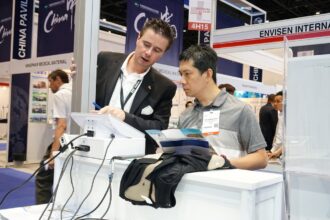The human spine is one of the primary support structures for the human skeleton. It is a complex arrangement of bone, cartilage, and ligaments that protects the spinal cord, supports and balances the head and upper torso, absorbs shocks, provides an anchor for the ribs, and enables a wide range of motion. Due to its complexity—and, some scientists maintain, to an imperfect adaptation to the dynamics of walking upright—the spine can manifest an array of disorders, with symptoms ranging from mild irritation to agonizing incapacitation.
The human spine is one of the primary support structures for the human skeleton. It is a complex arrangement of bone, cartilage, and ligaments that protects the spinal cord, supports and balances the head and upper torso, absorbs shocks, provides an anchor for the ribs, and enables a wide range of motion. Due to its complexity—and, some scientists maintain, to an imperfect adaptation to the dynamics of walking upright—the spine can manifest an array of disorders, with symptoms ranging from mild irritation to agonizing incapacitation. Many degenerative conditions of the spine appear later in life and are considered a normal result of the aging process.
The spine is comprised of four major components: vertebrae, joints, discs, and nerves, all of which are held together by a series of supporting ligaments. Twenty-four vertebrae make up the spine: seven cervical vertebrae form the neck, twelve thoracic vertebrae form the upper back, and five lumbar vertebrae form the lower back. Also considered part of the spinal column are the sacrum and coccyx. The sacrum is made up of five fused vertebrae and anchors the spine to the pelvic girdle. The coccyx, or tailbone, helps protect the lower alimentary tract and is made up of a semi-flexible series of three to five rudimentary vertebrae. Most vertebrae have lateral processes, one on each side, which anchor the ligaments and muscles involved in the bending and twisting of the vertebral column.
Diseases and disorders of the spine are the focus of a significant current market and continued development by medical device manufacturers. Targets of surgical procedures and medical devices for treatment of spine conditions include:
- Degenerative diseases of the spine
- Degenerative disc disease
- Herniated disc
- Spondylolisthesis
- Spinal stenosis
- Osteophytes or bone spurs
- Epidemiology of disc-related spinal disease
- Treatment of disc-related spinal disease
- Congenital disorders of the spine
- Adult spinal deformity
- Scoliosis
- Congenital scoliosis
- Neuromuscular scoliosis
- Degenerative scoliosis
- Idiopathic scoliosis
- Epidemiology of scoliosis
- Kyphosis
- Gibbus deformity
- Scheuermann’s disease
- Congenital kyphosis
- Secondary kyphosis
- Epidemiology of kyphosis
- Hyperlordosis
- Causes of lordosis
- Epidemiology of lordosis
- Ankylosing spondylitis
- Diagnosing spondylitis
- Epidemiology of spondylitis
- Treatment of congenital disorders of the spine
- Autoimmune diseases of the spine
- Rheumatoid arthritis
- Diagnosing spinal rheumatoid arthritis
- Epidemiology of rheumatoid arthritis
- Osteoarthritis
- Diagnosing osteoarthritis
- Spondylosis
- Epidemiology of osteoarthritis
- Treatment of autoimmune spinal disorders
- Rheumatoid arthritis
- Spinal tumors
- Epidemiology of spinal tumors
- Treatment of spinal tumors
- Traumatic spinal injury
- Fracture classification
- Vertebral compression fractures (VCFs)
- Epidemiology of spinal injury
- Treatment of traumatic spinal injury
These conditions and trauma are diverse, with significant and growing caseload. As a result, many technologies have been developed, and are in development, for their treatment. These include, at a minimum:
- Spinal fusion and fixation devices
- Posterior pedicle screw fusion systems
- Anterior cervical plate (ACP) systems
- Interspinous process spacers (ISP)
- Interbody fusion devices
- ALIF
- TLIF
- PLIF
- Spinal fixation devices
- Dynamic stabilization devices
- Artificial discs
- Vertebroplasty devices
- Balloon kyphoplasty devices
- Biologics
- Spinal allografts
- Demineralized bone matrix (DBM)
- Platelet-derived growth factors (rhBMP)
The conditions and technologies in spine surgery are detailed in report #M520, “Worldwide Spine Surgery 2011: Products, Technologies, Markets & Opportunities, Worldwide, 2010-2020.” Publishing May 2011 by MedMarket Diligence.








